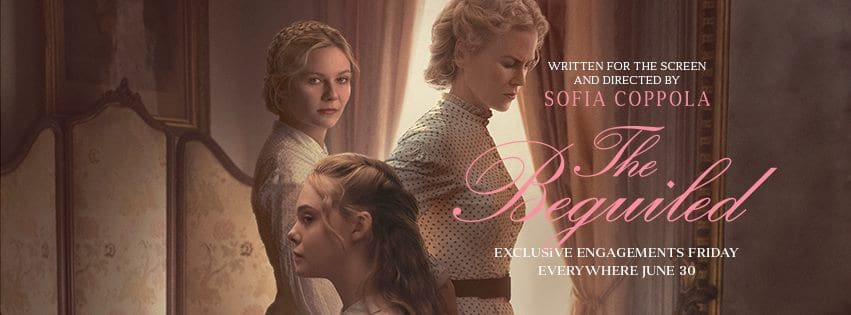In a recent GQ interview, director Sofia Coppola admitted that she had never heard of the Bechdel Test. While that gap in knowledge may seem egregious considering Coppola’s oeuvre, Alison Bechdel herself once conceded that having two female characters have a single conversation that isn’t about a man is a pretty low bar to set for any movie. While The Beguiled only narrowly passes the test, the film is probably one of the most female-centric films of the year.
Given that, it may seem odd to start this review by talking about Colin Farrell’s character, Coporal John McBurney, but he is the focus and impetus for the female characters’ actions. The movie starts when a young girl finds him in the woods and brings the wounded soldier back to her girls-only boarding school on a decrepit Southern plantation. McBurney makes the women nervous not just because he’s a Union soldier, but because he’s the first man to penetrate their way of life in a long time. For his part, Farrell makes it easy to understand why the women are so flustered around him. The actor has perhaps never been more charming and allowing him to actually be Irish within the film’s world gives him an air of both exoticism and nobility that would naturally ingratiate him to refined Southern women.
However, what really makes Farrell so compelling is that McBurney functions in the film in a way female characters usually do. Typically, fictional women use their wiles to get what they want out of men, but in this case, Farrell is the Cleopatra surrounded by female Antonys and Caesars of various ages. McBurney knows his status in this environment is tenuous and he unleashes his charm on every woman in the house in hopes of ensuring his safety. The result isn’t as silly as you’d think.
Though Coppola infamously took a lot of artistic license with 2006’s Marie Antoinette, she delivers a serious period piece here. However, that doesn’t mean the film lacks a sense of style. Coppola and cinematographer Philippe Le Sourd opted largely for natural light or candlelight, so shadows are always encroaching upon the images. A sinister sense of foreboding permeates the film and the abnormal aspect ratio (the 1.66:1 often used by Stanley Kubrick) further creates a sense that there’s something slightly off here. Coppola takes the story seriously–bonkers as it is–and keeps it from becoming full-blown camp. Still, that’s not to say that the actresses themselves don’t occasionally have fun with the material.
Fanning probably comes closest to overdoing it. Almost like the actress herself, Alicia is right in the middle of her shift from girl to woman and McBurney’s arrival is the spark that ignites her burgeoning sexuality. Rendered by a less skilled actress, Alicia’s exaggerated movements and bedroom eyes could be mistaken for overacting, but Fanning’s performative behavior makes sense for a girl who understands the concept of sexuality but not the practice. Her character deliberately lacks the subtlety (and frankly, repression) that an older woman like Kidman’s character, Miss Martha, has already mastered.
In the 1971 original, Geraldine Page played Miss Martha as borderline unhinged—the embodiment of the old time-y concept of the “hysterical” woman. Kidman’s take is far subtler, but no less effective. While the rest of the characters seem somewhat unconscious of the way their behavior changes in response to McBurney, Miss Martha is aware from the beginning, when simply washing the sleeping soldier’s exposed skin makes her breathless. Every decision she makes for the rest of the film is informed by that moment and Kidman does such a good job of selling that wariness that the audience barely notices its underlying danger until things get extreme.
Make no mistake, as mannered and suggestive as The Beguiled is for much of its runtime, it delivers on the craziness promised in the trailer. To detail exactly what form that craziness takes would spoil the fun, but there is one major flaw. In adapting the story anew to tell it from the women’s perspective, Coppola inevitably makes it more sympathetic to them. Mostly, that’s a good thing, but in placing more blame for what eventually happens to McBurney on his actions, she also makes him act in a way that doesn’t quite fit with what we see for the rest of the film. It seems improbable at best that after so skillfully manipulating every woman in the house, McBurney would make a critical misjudgment just when it matters the most.
The gender politics in The Beguiled were always a little messy—that’s kind of the point. Thomas Thomas P. Cullinan’s original novel, A Painted Devil, was clearly reacting to the seeds of the feminist movement that reached full bloom by the time the first film hit theaters in ’71. It’s impossible to ignore the misogyny that underlies both and while Coppola mostly manages to wrest narrative control from the male perspective, the result is still a bit muddled. But then, this particular moment in history is filled with muddled gender politics, maybe this is exactly the movie we need.


